Graham Slee Accession MC Moving Coil Phono Preamplifier
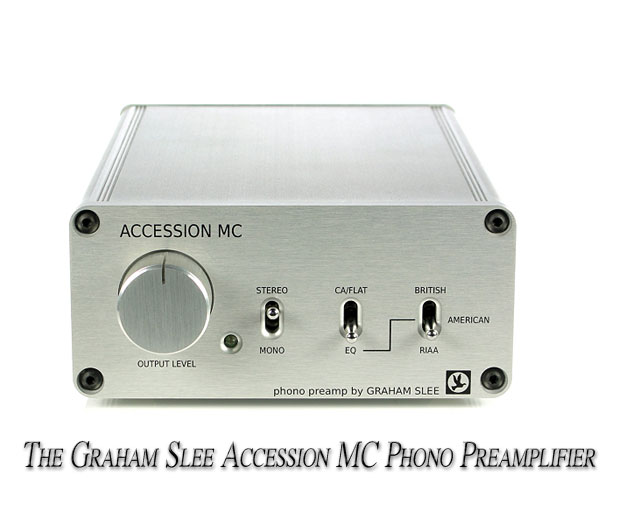
After my ecstatic listening experiences with the Graham Slee moving-magnet Accession phono preamp, reading of Slee’s travails in developing a low-output MC version Accession at his UK website’s Forum section (here) did not surprise me. Similar to what Slee reveals in that Forum, I have to admit to also being a dissenter from the audiophile dogma that the moving-coil is the supreme phono cartridge design.
Historically that dogma began to arise in the US during the 1970’s through the advocacy of Harry Pearson in The Absolute Sound of the concept of “the high end”, the emergence of the visually-listening audiophile style in the USA, and the influence of Japanese home market products on the world market (specifically, the mysterioso world of exotic MC cartridges supposedly made by ex-Samurai sword makers, with diamonds polished by the tresses of Circassian maidens, and the like.) Linn’s importing of the Supex MC cartridge line into the UK, and later using Audio Technica to manufacture their Linn-badged MC as a top choice for the Sondek LP 12 gave the low-output MC an immediate premier status.
I was running a High-Performance audio store in a Midwestern University town at the time, while also pursuing, rather desultorily, a graduate school path. As youngbloods in our mid-20’s hearing-acuity prime, our sales staff scoffed at the emerging audiophile high-end products, finding them way too bright, way too lame musically, and way way too expensive. Were they aimed exclusively at well-off older men already well advanced in presbycusis-induced hearing loss?
 I personally was just beginning to concentrate my listening on the 1,000+ year tradition of Western Art music. I was discovering that audio products that were excellent in reproducing Rock, Jazz, Blues, and Folk music, simply fell apart when trying to accurately reproduce the sound of Classical orchestra instruments. The violin was the acid test: get it wrong and almost the entire corpus of Classical music falls apart. Fiendishly difficult to reproduce accurately because of its complex overtone structure (yes, the violin’s harmonics include that horror-of-horrors desideratum requiring mechanical stylus displacements equal to wave-lengths of light,) the violin taxed most phono cartridges beyond their limits.
I personally was just beginning to concentrate my listening on the 1,000+ year tradition of Western Art music. I was discovering that audio products that were excellent in reproducing Rock, Jazz, Blues, and Folk music, simply fell apart when trying to accurately reproduce the sound of Classical orchestra instruments. The violin was the acid test: get it wrong and almost the entire corpus of Classical music falls apart. Fiendishly difficult to reproduce accurately because of its complex overtone structure (yes, the violin’s harmonics include that horror-of-horrors desideratum requiring mechanical stylus displacements equal to wave-lengths of light,) the violin taxed most phono cartridges beyond their limits.
The late and great Joseph L. Grado held patents on the moving-coil cartridge, yet he did not produce a moving-coil cartridge himself. This fact was telling and enlightening. Grado himself sang Opera, and was intensely aware that the mid-range was key to believable music reproduction. His range of moving-iron cartridges not only got the midrange right, but they also passed the violin test with an ease that made them a top choice for acoustic instrument playback. While his “Joseph L Grado Signature” cartridges were one of the first to break the $1000 price mark, he also produced cartridges that could be bought for $20.
There’s no question that the moving-coil cartridges of the time could sound spectacularly detailed, dynamic, and with extended response at the limits of the frequency band, both high and low. Their performance fed the growing trend of ‘visual listening’ (the focus on sound-staging and imaging as ultimate determiners of worth) and “Hi-Fi Spectacular’ US audiophile demands. I found far too many of them painfully bright, musically inept, and timbrally faulty.
Their problems extended to finding the ‘right’ arm to mount them in (many were of extremely low compliance and demanded high mass arms), living with their at times limited tracking ability, and finding truly accurate and affordable high-gain phono stages.
For me, they also had to pass the violin acid test. Few did: either erring on the side of sounding like the violin was strung with steel strings, or being so saturated with midrange 2nd-harmonic distortion coloration as to require insulin injections while listening.
 I’ve lived with, sold, owned, reviewed, or extensively auditioned innumerable low-output moving coil cartridges over the last 40 years. I have to admit that I found too many of them lacking in the basics of music making: rhythm, timing, punctuation, and phrasing tended to the so-so. While their detail and sound staging could be thrilling, they were often bought at the price of a rising high-frequency response that skewed the harmonics of the instruments. I’ve only found one that completely passed all my criteria for audio reproduction: the accurate and unambiguous ability to tell me what instrument is playing, where it is, what it’s playing, and why it’s playing it. That cartridge, now discontinued, unfortunately cost $6000, a sum I found rather insane at the time, and still do.
I’ve lived with, sold, owned, reviewed, or extensively auditioned innumerable low-output moving coil cartridges over the last 40 years. I have to admit that I found too many of them lacking in the basics of music making: rhythm, timing, punctuation, and phrasing tended to the so-so. While their detail and sound staging could be thrilling, they were often bought at the price of a rising high-frequency response that skewed the harmonics of the instruments. I’ve only found one that completely passed all my criteria for audio reproduction: the accurate and unambiguous ability to tell me what instrument is playing, where it is, what it’s playing, and why it’s playing it. That cartridge, now discontinued, unfortunately cost $6000, a sum I found rather insane at the time, and still do.
Consequently, I never pursued LOMC cartridges with any fervor or keen interest, and instead focused my attention on the high-quality moving magnet and moving-iron designs. My drawers are full of moving-coil cartridges that didn’t win the cigar, cut the mustard, or ring the bell, now long neglected and almost forgotten.
It’s true that our current Golden Age of Analogue LP playback has resulted in simply quantum-leap performance improvements over the last years in cartridges, set-up procedures, stylus types, turntables, tonearms, isolation devices, and phono stages. It’s been a genuine pleasure searching out the most intriguing products of our analogue revival and reporting on them.
A welcome trend in MC cartridge development since the turn of the Millennium has been to tame the exaggerated high-frequency response of previous designs to a more natural result. One need only listen to the iterations of Audio Technica’s long-running AT OC9: each subsequent model, to OC9ML, to OC9MLII, to the contemporary 09MLIII, to trace the changes in performance of the top octaves.
I was over the moon, if not certifiably lunatic, by the musical and sonic performance of the Graham Slee Accession MM phono stage. (review here) Mated to other elements in the analogue front end of equal natural transparency and inerrant music-making ability, I found myself transcending the boundary between audio playback and live experience. The artistic results and the aesthetic effects were so profound and deeply satisfying that thought of bettering the performance lost any meaning.
Graham Slee had long been working on a new MC preamp to surpass his EXP Elevator MC head-amp, which requires a conventional mm gain-stage phono section (documented in the Forum section on his website.) The result is the new Accession MC low-output moving-coil phono stage. Retailing at $ 1398 with the PSU1 power supply, and at $ 1619.53 with Slee’s new PSU1 Enigma power supply, the Accession MC slots in roughly equivalent in price to the MM Accession. The stalwart Elevator EXP MC head-amp, which actively amplifies MC signals to a level where it can drive any existing MM phono stage, sells for $1115.
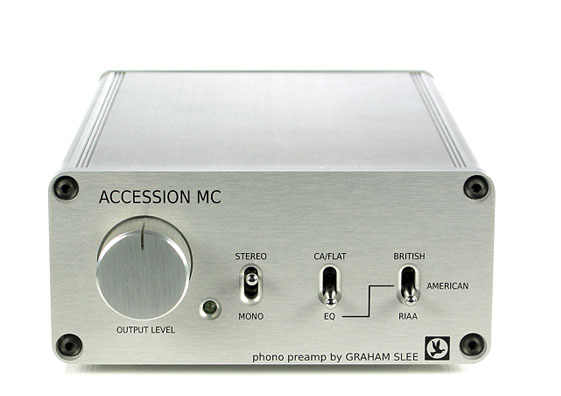
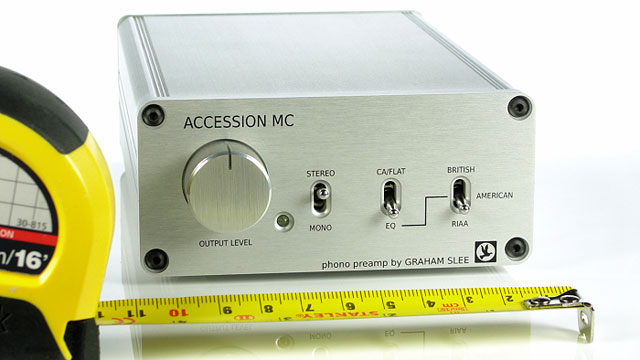
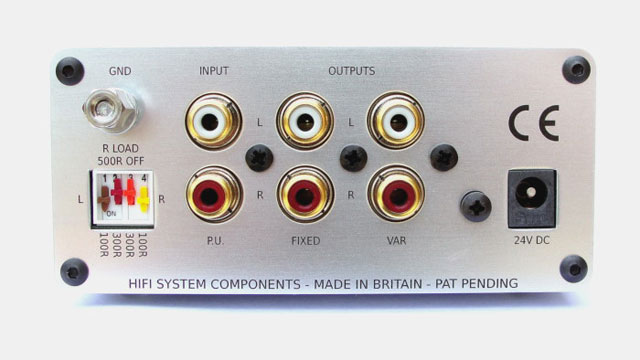
Cosmetically, and in features, the MC matches the Accession MM: both offer an additional variable line out (controlled by a front panel volume control for those desiring to drive a power amp sans active line-stage pre-amplification,) both feature selectable LP equalization choices, and stereo/mono switching from the front panel. The Accession MC offers cartridge loading up to 500 ohms. Gain is 61.3 dB, Signal-to-Noise Ratio is 65 dB, and stereo separation is 60 dB.
 Like all of Graham Slee’s products, the MC has no power switch, and is designed to be left on all the time. Stabilization of the circuit (the capacitors specifically) requires a long time after initial AC connection. I waited for 7 days before beginning serious listening, though the greatest changes occurred during the first 72 hours.
Like all of Graham Slee’s products, the MC has no power switch, and is designed to be left on all the time. Stabilization of the circuit (the capacitors specifically) requires a long time after initial AC connection. I waited for 7 days before beginning serious listening, though the greatest changes occurred during the first 72 hours.
The Accession MC is an ultra-resolution thoroughbred device and demands great care in front-end set-up. Slight errors or sloppiness in cartridge/arm adjustment and alignment (especially for VTA/SRA settings) will be immediately audible. Fortunately, its high resolution will also reveal correct set-up with dependable certainty. That characteristic is also shared by Origin Live’s arms, making set-up far less fraught with ambiguity. Finding the Goldilockian Ideal of “Just Right” was less an ordeal and more a joyful adventure.
A useful model for judging a hi-fi system’s performance is the analogy of viewing a landscape through a large multi-pane glass picture window. Each component equates to an individual plane of glass in that window. The clarity and accuracy of the view will depend on the quality of each pane: any warping, smudging, fogging, dirt, or distortion will alter the view. Ultimately, one would want all those panes to completely disappear. It is obvious also that one flawed pane will set the limit of the accuracy of the view.
It was immediately obvious that the Accession MC was never the flawed glass pane in any front-end/system I tried it in. I listened to the MC with 5 different turntables and arms, with 8 different MC cartridges, into 3 different systems (both solid-state and tube-based) and 4 different speakers.
The Accession MC was revealed as an ultra-high resolution, ultra-neutral phono stage. Common to all the configurations in which I auditioned it were some very desirable abilities. The soundstage always exceeded the boundaries of the speaker placement, and with the higher performance front-ends, the boundaries of the listening room itself. The ambience of the recording venue was always captured with a refreshing clarity and orienting naturalness, and instrument placement was so precise that it triggered synaesthetic visual response. Bandwidth was ultra-wide and balanced. Dynamic range was simply enormous and, most importantly, capable of tracking the subtlest of low-level inflections and instrumental expressiveness. Music-making, as with the MM Accession, was direct and faithful, completely devoid of artistic distortion. Indeed, the only flaws I heard with the Accession MC were those of the cartridges I used with it.
The group of cartridges I used was fairly motley. I listened to: an antique Ortofon SPU (re-tipped with a line-contact stylus by the new Garrott Bros (Australia,) two versions of the Audio Technica AT-OC9ML – the I and the current III, a near-antique Talisman Boron, the Dynavector Karat D3, the Denon DL 301 MKII, a Hana SL, and a Goldring Eroica LX (with a Garrott Bros (Australia) Geiger Signature stylus.) Only 4 of these cartridges are currently available new and only two of them do I use with any regularity (the Eroica LX for its overall sonic and musical excellence and OC9 MLIII for its synergy with my Linn Sondek LP12 turntables.)
Traditionally the Achilles’ Heal of many low-output MC cartridges has been the subjective perception that is often described as an unnatural brightness and a kind of electronic ‘steeliness.’ While tipped-up frequency response is popularly claimed as the culprit, it is more likely that the cause is intermodulation and transient distortions in the 3 to 6 kHz range and above. Whether caused by tracking limitations of the cartridge’s stylus per se, the combined mass of the cantilever and coils, the inability of the MC phono section to cleanly deal with the information, impedance loading error, tonearm resonances or, most likely, the combination of all five, one of Slee’s goals in the development of the C was to eliminate that steely and un-natural distortion. He attempted this not by rolling off the offending frequency range – smearing Vaseline on the window pane in an attempt to flatter – but by heightening the resolution and lowering the distortion.
Two of my tested cartridges fit that type of MC cartridge aberration – the Talisman Boron and the Audio Technica OC9ML. The upper mid-range/lower treble was refreshingly free of harshness and sting, though both cartridges’ rising high-ends were still clearly perceptible. Interestingly, both had previously ultimately failed my Violin Acid Test by skewing the higher harmonics of the instrument toward the un-natural. That all changed when mounted in my top Origin Live arms: the Accession MC revealed that they were capable of much more natural accuracy than I had ever suspected them of. Yes, they were finally awarded the cigar.
As I worked through the rest of the cartridges and systems it became obvious that the Accession MC was a completely transparent pane in the picture window; indeed it was hard to avoid the perception that it was a completely open window: no glass pane at all. The merits of each cartridge/front end were sledge-hammer-blow-on-the-head obvious; their limitations equally obviously revealed. The Accession MC served as a supremely reliable analytic and aesthetic tool for judging phono cartridge performance. The difference between stylus types/profiles, cantilever materials, and other variations among the cartridges were unusually clear and, thus, allowed forming accurate and dependable judgments of merit.
Want to hear the exact difference between an elliptical stylus and a line-contact type? The Accession MC will tell you. Want to hear the differences between Shibata, MicroRidge, MicroLine, Fritz Geiger, or Van den Hul line-contact stylus profiles? The Accession MC will tell you. Want to hear the difference between aluminum, boron, diamond, ruby, beryllium or sapphire cantilevers? Again, the Accession MC (like its MM brother) will tell you.
The Accession’s ‘no glass in the window pane’ characteristic means its analytic strength does not come from sterility, revelation of irrelevant trivial sonic minutiae, or artificial spot-lighting, but from the sensation of natural-ness, completeness, fidelity, and above all, musical communication. While each cartridge I played sounded the best I’d ever heard it, even while each one’s limits were open to perception, it was their musical merits that were the most immediate.
 This last characteristic of the Accession MC – the ability to communicate the musical meaning and merit of a recording – I find to be its most valuable asset. Too many ‘high end’ moving-coil based front ends I’ve heard have compromised the musical message for the sake of hallucinatory sound staging and ‘Stereo Spectacular’ special effects. Unless timing, rhythm, parsing, punctuation and tracking of low-level dynamic flow are up to the demands of the music, artistic distortion sets in – a flaw I find completely unacceptable. Thankfully, Accession MC allowed access to the art of the music as well as its sibling the Accession MM.
This last characteristic of the Accession MC – the ability to communicate the musical meaning and merit of a recording – I find to be its most valuable asset. Too many ‘high end’ moving-coil based front ends I’ve heard have compromised the musical message for the sake of hallucinatory sound staging and ‘Stereo Spectacular’ special effects. Unless timing, rhythm, parsing, punctuation and tracking of low-level dynamic flow are up to the demands of the music, artistic distortion sets in – a flaw I find completely unacceptable. Thankfully, Accession MC allowed access to the art of the music as well as its sibling the Accession MM.
The Accession MC shares its feature list with the Accession MM. As with the MM, I found some of these features moot: all my LP’s (12,000 + when I last counted)) use the RIAA equalization standard, so the switchable EQ choices found no application. The ability to by-pass EQ altogether for those transferring analogue LP into a digital form through the use of a digital converter I also found useless. Why take an ultra-high resolution signal and compromise it by converting it to a limited and thus inferior level of resolution? Makes no sense to me.
The ability to create an LP-only dedicated system by using the C’s variable line out feature to directly drive the power amps certainly has appeal for those with ‘purist’ inclinations. As with the M, I found no “Eureka Moment” improvement in by-passing an active line stage, except perhaps with my most “entry-level” preamp (i.e., an old NAD 1020.) On the other hand, I found no obvious sonic corruption by using the Accession in direct mode, except for that signature loss of mid-bass drive and musically rhythmic brio that I’ve heard in every passive preamp system I’ve auditioned over the last 30 years. I tried 5 different amplifiers in this direct/ passive mode (including Slee’s own marvelously musical Proprius mono amps.) The effect is most obvious on strongly rhythmic bass/drum driven music (Rock and Jazz) but also affects Classical music. In every case I preferred an active line stage preamp over the direct/passive mode.
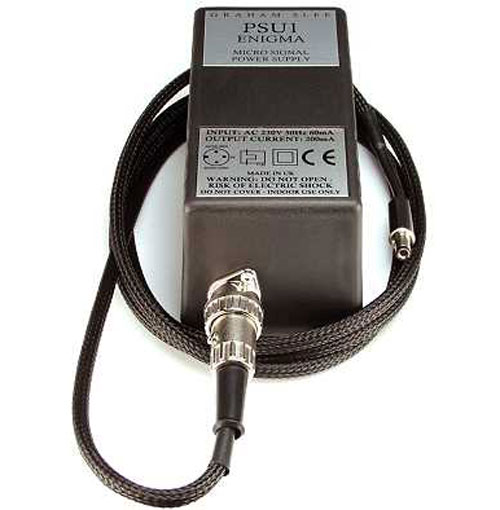
The Accession MC is available with 2 different power supplies: the new Enigma and the PSU-1. Comparing the two, while seeming initially very subtle, showed a clear superiority of the Enigma in naturalness. The soundstage was wider, allowing individual instruments a more concrete place in the stage. Bass dynamics were also increased, as was the sonority of the bass instruments, which became richer and fuller, while still maintaining their agility and speed. The net result was a subtle shift in the tonal center of the sound, one more natural and organic. The more one listens to acoustic, un-amplified music, the greater the pay-off of the Enigma.
 Testing the Enigma power supply with the Accession M and the Reflex M showed the same improvements, as did the Elevator EXP head amp. The Enigma power supply retails for $469 separately and can be used to upgrade many of Slee’s other products. There being only a $200 difference in price of a new Accession MC with the Enigma over the standard PSU-1 supply, the Enigma is a bargain. Still I can easily imagine listeners exclusively devoted to amplified music either preferring, or being completely satisfied with the PSU-1.
Testing the Enigma power supply with the Accession M and the Reflex M showed the same improvements, as did the Elevator EXP head amp. The Enigma power supply retails for $469 separately and can be used to upgrade many of Slee’s other products. There being only a $200 difference in price of a new Accession MC with the Enigma over the standard PSU-1 supply, the Enigma is a bargain. Still I can easily imagine listeners exclusively devoted to amplified music either preferring, or being completely satisfied with the PSU-1.
The Graham Slee Owners Group, as evidenced by member posts on Slee’s website Forum tends to the sophisticated, helpful, and congenial. Many of them using MC cartridges use Slee’s Elevator EXP to drive a MM phono stage (as have I in the past.) The question arises: Does the Accession MC outperform the Elevator EXP driving the MM Accession (or any other ultra-quality phono stage? A universally valid answer hinges on the contingency of the associated components’ ultimate resolution and fidelity. Also to be considered is the difference in cost. While I found that I preferred the Accession MC over the Elevator EXP/Accession MM and Elevator/Reflex M, neither of the two latter options were even remotely likely candidates for incipient defenestration. Both were excellent: the Accession MC was just that bit more ‘excellenter’.
The simplest and most economical path is to buy the Accession MC with the Enigma power supply. If one already owns an Elevator EXP running into the Accession MM, the obvious path would be to upgrade the power supply of both to the Enigma.
The improvement in all aspects of Analogue LP playback during this millennium has been nothing short of astounding. The increase in quality of phono cartridges has led to the point that it is very hard to find a complete dud among contemporary designs. Moving magnet, moving-iron, high-output moving coil, and low output moving coils have improved so significantly and converged so successfully in sonic and musical performance that the old Moving Magnet vs. Moving Coil dogmatic dichotomy no longer holds.
High and ultra performance in the Analogue LP realm can never be chump-change cheap, and the jump in phono cartridge prices over the last years has resulted in a new transition point in price to obtain more-or-less uncompromised performance: the roughly $600 to $1000 range. This transition point will include top moving-magnet designs with top stylus/cantilevers, some of the better moving-iron designs and high-output moving coils, but mostly only the least expensive entries into low-output moving coil territory. I don’t think it is currently possible to convincingly argue that a LOMC is inherently superior in this price category. Indeed it is hard to argue that the moving coil is indeed superior up to the $2500 price point. Above that price, the LOMC indeed rules, largely because mostly only LOMC’s are priced that high. The question then becomes: Does a $3000 cartridge out-perform a $1000 one? The answer then is: If it doesn’t, why does it even exist? Quality of performance thus no longer hinges on type of generating system within the cartridge but on the holistic combination of all the particular cartridge’s individual elements. I can think of quite a few cartridges of differing generating principles whose performance so closely overlaps each other’s that identifying them purely by type would challenge even experienced listeners.
Listening to the Accession MC was a profoundly stimulating educational experience. Its utterly transparent, ultra- resolution permits reliable judgment of any MC’s performance, both sonically and musically, without sharing outrageous “High End” rip-off-the-rich-twits pricing.
An advantage of long historical experience with things audio is that it gives perspective to contemporary developments. A disadvantage is that past experiences can skew that perspective. It was extremely edifying revisiting old rejected MC cartridges through the lens of the Accession MC. Hearing them in this new light allowed me to see if earlier judgments were justified and reaffirmed. It was doubly satisfying to hear that the older judgments were no longer completely valid. Through the graces of the Accession MC and the playback neutrality of Origin Live’s tonearms, it is not hard to feel that one is doing objective justice to the performance of LOMC cartridges. As such it is a completely welcome and indispensable product. It is as revelatory to the performance of LOMC cartridges as the Accession MM is to the other cartridge types, and that is no mean achievement. The highest of recommendations then for this truly superb product.

![]()
paul szabady
Specifications:
Price: $1619.00
Input and output connectors: 360° shielded RCA/phono sockets, hard gold plated
Input sensitivity range: 0.125mV to 0.84mV (recommended)
Output range (for above inputs): 145mV to 975mV
Maximum input: 4.2mV rms
Maximum output: 4.876V rms
Gain61.3dB (1161) at 1kHz
Input impedance: 500, 300, 100 and 75 Ohms (300 plus 100 both on)
Output impedance (driving impedance): 750 Ohm fixed OP/ 470 Ohm variable OP (will drive ≥10k Ohms)
Noise at output-65dB A wtd. 20Hz to 20kHz 0dBu out
Distortiontypically 0.02% 20Hz to 20kHz
RIAA accuracy± 0.3dB (sampled)
Frequency response: 20Hz – 100kHz (±0,−1dB normalised)
Channel balance: 0.2dB
Channel separation: 60dB
Power supply: remotely powered using PSU1 linear power supply
Size (approx.): W: 107 x H: 50 x D: 195 (mm) inc. jacks
Graham Slee
HiFi System Components Limited
6 Buttercross Drive
Little Houghton, S72 0HS
England
+44 (0) 1909 568739
+44 (0) 7947 107188
+44 (0) 1226 755328
Email: gsp.ltd@gspaudio.co.uk
website: www.hifisystemcomponents.com
twitter: twitter.com/gspaudio
US Distributor:
LP Gear
3024 Via VeneziaHenderson, NV 89052 US
Fax: (725) 888-4711
https://www.lpgear.com/SFNT.html
One thought on "Graham Slee Accession MC Moving Coil Phono Preamplifier"
Leave a Reply
Stereo Times Masthead
Publisher/Founder
Clement Perry
Editor
Dave Thomas
Senior Editors
Frank Alles, Mike Girardi, Russell Lichter, Terry London, Moreno Mitchell, Paul Szabady, Bill Wells, Mike Wright, and Stephen Yan,
Current Contributors
David Abramson, Tim Barrall, Dave Allison, Ron Cook, Lewis Dardick, John Hoffman, Dan Secula, Don Shaulis, Greg Simmons, Eric Teh, Greg Voth, Richard Willie, Ed Van Winkle, Rob Dockery, Richard Doran, and Daveed Turek
Site Management Clement Perry
Ad Designer: Martin Perry






Will this Accession MC phono pre-amp .effectively work in driving a Sugden AI-4 pure class A ,Intergraded Amp. or will it clip and distort the sound .